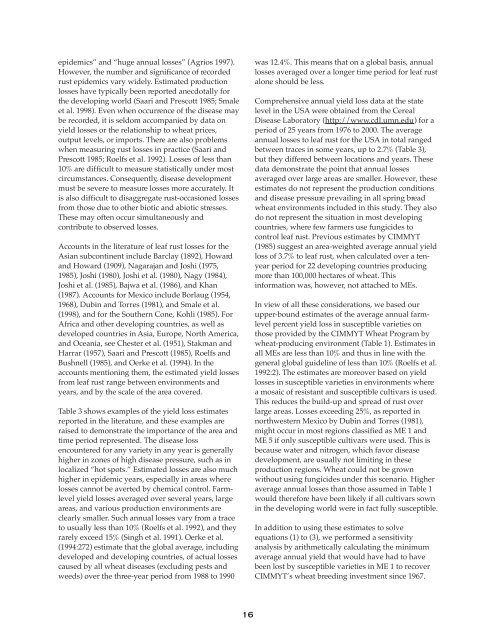The Economic Impact in Developing Countries of ... - AgEcon Search
The Economic Impact in Developing Countries of ... - AgEcon Search
The Economic Impact in Developing Countries of ... - AgEcon Search
- No tags were found...
Create successful ePaper yourself
Turn your PDF publications into a flip-book with our unique Google optimized e-Paper software.
epidemics” and “huge annual losses” (Agrios 1997).However, the number and significance <strong>of</strong> recordedrust epidemics vary widely. Estimated productionlosses have typically been reported anecdotally forthe develop<strong>in</strong>g world (Saari and Prescott 1985; Smaleet al. 1998). Even when occurrence <strong>of</strong> the disease maybe recorded, it is seldom accompanied by data onyield losses or the relationship to wheat prices,output levels, or imports. <strong>The</strong>re are also problemswhen measur<strong>in</strong>g rust losses <strong>in</strong> practice (Saari andPrescott 1985; Roelfs et al. 1992). Losses <strong>of</strong> less than10% are difficult to measure statistically under mostcircumstances. Consequently, disease developmentmust be severe to measure losses more accurately. Itis also difficult to disaggregate rust-occasioned lossesfrom those due to other biotic and abiotic stresses.<strong>The</strong>se may <strong>of</strong>ten occur simultaneously andcontribute to observed losses.Accounts <strong>in</strong> the literature <strong>of</strong> leaf rust losses for theAsian subcont<strong>in</strong>ent <strong>in</strong>clude Barclay (1892), Howardand Howard (1909), Nagarajan and Joshi (1975,1985), Joshi (1980), Joshi et al. (1980), Nagy (1984),Joshi et al. (1985), Bajwa et al. (1986), and Khan(1987). Accounts for Mexico <strong>in</strong>clude Borlaug (1954,1968), Dub<strong>in</strong> and Torres (1981), and Smale et al.(1998), and for the Southern Cone, Kohli (1985). ForAfrica and other develop<strong>in</strong>g countries, as well asdeveloped countries <strong>in</strong> Asia, Europe, North America,and Oceania, see Chester et al. (1951), Stakman andHarrar (1957), Saari and Prescott (1985), Roelfs andBushnell (1985), and Oerke et al. (1994). In theaccounts mention<strong>in</strong>g them, the estimated yield lossesfrom leaf rust range between environments andyears, and by the scale <strong>of</strong> the area covered.Table 3 shows examples <strong>of</strong> the yield loss estimatesreported <strong>in</strong> the literature, and these examples areraised to demonstrate the importance <strong>of</strong> the area andtime period represented. <strong>The</strong> disease lossencountered for any variety <strong>in</strong> any year is generallyhigher <strong>in</strong> zones <strong>of</strong> high disease pressure, such as <strong>in</strong>localized “hot spots.” Estimated losses are also muchhigher <strong>in</strong> epidemic years, especially <strong>in</strong> areas wherelosses cannot be averted by chemical control. Farmlevelyield losses averaged over several years, largeareas, and various production environments areclearly smaller. Such annual losses vary from a traceto usually less than 10% (Roelfs et al. 1992), and theyrarely exceed 15% (S<strong>in</strong>gh et al. 1991). Oerke et al.(1994:272) estimate that the global average, <strong>in</strong>clud<strong>in</strong>gdeveloped and develop<strong>in</strong>g countries, <strong>of</strong> actual lossescaused by all wheat diseases (exclud<strong>in</strong>g pests andweeds) over the three-year period from 1988 to 1990was 12.4%. This means that on a global basis, annuallosses averaged over a longer time period for leaf rustalone should be less.Comprehensive annual yield loss data at the statelevel <strong>in</strong> the USA were obta<strong>in</strong>ed from the CerealDisease Laboratory (http://www.cdl.umn.edu) for aperiod <strong>of</strong> 25 years from 1976 to 2000. <strong>The</strong> averageannual losses to leaf rust for the USA <strong>in</strong> total rangedbetween traces <strong>in</strong> some years, up to 2.7% (Table 3),but they differed between locations and years. <strong>The</strong>sedata demonstrate the po<strong>in</strong>t that annual lossesaveraged over large areas are smaller. However, theseestimates do not represent the production conditionsand disease pressure prevail<strong>in</strong>g <strong>in</strong> all spr<strong>in</strong>g breadwheat environments <strong>in</strong>cluded <strong>in</strong> this study. <strong>The</strong>y alsodo not represent the situation <strong>in</strong> most develop<strong>in</strong>gcountries, where few farmers use fungicides tocontrol leaf rust. Previous estimates by CIMMYT(1985) suggest an area-weighted average annual yieldloss <strong>of</strong> 3.7% to leaf rust, when calculated over a tenyearperiod for 22 develop<strong>in</strong>g countries produc<strong>in</strong>gmore than 100,000 hectares <strong>of</strong> wheat. This<strong>in</strong>formation was, however, not attached to MEs.In view <strong>of</strong> all these considerations, we based ourupper-bound estimates <strong>of</strong> the average annual farmlevelpercent yield loss <strong>in</strong> susceptible varieties onthose provided by the CIMMYT Wheat Program bywheat-produc<strong>in</strong>g environment (Table 1). Estimates <strong>in</strong>all MEs are less than 10% and thus <strong>in</strong> l<strong>in</strong>e with thegeneral global guidel<strong>in</strong>e <strong>of</strong> less than 10% (Roelfs et al.1992:2). <strong>The</strong> estimates are moreover based on yieldlosses <strong>in</strong> susceptible varieties <strong>in</strong> environments wherea mosaic <strong>of</strong> resistant and susceptible cultivars is used.This reduces the build-up and spread <strong>of</strong> rust overlarge areas. Losses exceed<strong>in</strong>g 25%, as reported <strong>in</strong>northwestern Mexico by Dub<strong>in</strong> and Torres (1981),might occur <strong>in</strong> most regions classified as ME 1 andME 5 if only susceptible cultivars were used. This isbecause water and nitrogen, which favor diseasedevelopment, are usually not limit<strong>in</strong>g <strong>in</strong> theseproduction regions. Wheat could not be grownwithout us<strong>in</strong>g fungicides under this scenario. Higheraverage annual losses than those assumed <strong>in</strong> Table 1would therefore have been likely if all cultivars sown<strong>in</strong> the develop<strong>in</strong>g world were <strong>in</strong> fact fully susceptible.In addition to us<strong>in</strong>g these estimates to solveequations (1) to (3), we performed a sensitivityanalysis by arithmetically calculat<strong>in</strong>g the m<strong>in</strong>imumaverage annual yield that would have had to havebeen lost by susceptible varieties <strong>in</strong> ME 1 to recoverCIMMYT’s wheat breed<strong>in</strong>g <strong>in</strong>vestment s<strong>in</strong>ce 1967.16
















